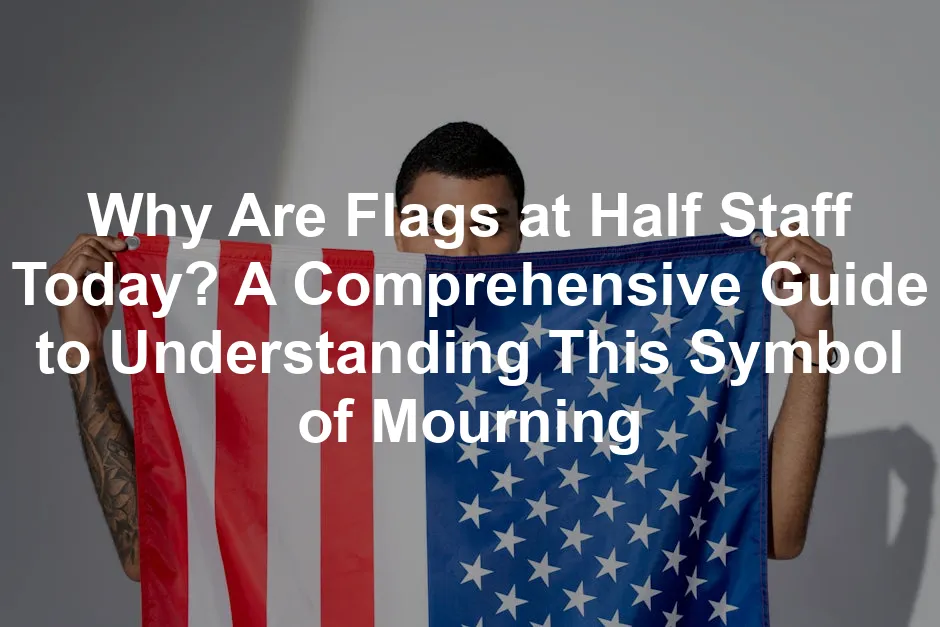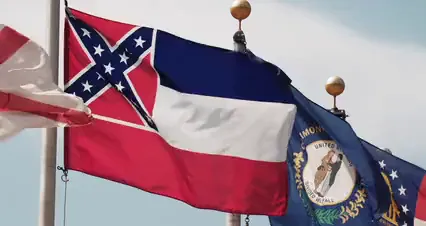
Why Are Flags at Half Staff Today? A Comprehensive Guide to Understanding This Symbol of Mourning
Introduction
In a world filled with vibrant colors and lively celebrations, the sight of flags flying at half-mast often evokes a moment of pause and reflection. But why do flags droop in this somber manner? It’s not just a random act; it’s a powerful symbol of mourning and respect. Whether it’s a national tragedy, the passing of a public figure, or a day of remembrance, the act of lowering flags carries with it a historical weight and cultural significance.
Flags at half-staff serve as a collective signal of sorrow. When you see a flag lowered, it communicates that something significant has happened. It’s a way for us to share in the grief of our nation, community, or even a family. Imagine a gathering of people, all looking up at a flag that symbolizes unity and freedom, only to see it hanging low. It reminds us that in times of loss, we are all connected.
This practice isn’t just an American custom. Many countries observe similar traditions. However, the reasons for flags being displayed at half-staff can differ widely. In the United States, the President, governors, and local officials can issue proclamations for half-staff days. These proclamations often coincide with tragic events, such as mass shootings or the deaths of notable figures.
In this article, we’ll explore the reasons behind this practice, provide context for its meaning, and keep you informed about current half-staff observances. So, the next time you see a flag at half-staff, you’ll know the story behind it! Understanding this symbol can deepen our appreciation for the moments of collective mourning, forcing us to reflect on the importance of those we’ve lost.
From historical roots to modern-day applications, the act of lowering flags is rich with meaning. It’s a reminder to pay our respects and acknowledge the sacrifices made by others. Let’s dive into this essential aspect of flag etiquette and discover the layers of meaning behind a half-staff flag.

Historical Context of Half-Staff Flags
The Origins of the Practice
The tradition of flying flags at half-staff boasts a long and varied history, reaching back to ancient customs. In many cultures, lowering a flag signified mourning or respect. In medieval Europe, flags were often displayed at half-mast during times of war or in response to the deaths of significant figures. This act communicated a shared sense of grief and loss, allowing communities to come together in solemnity.
Fast forward to the United States, where this age-old practice evolved into a formalized tradition. The first recorded instance of lowering flags in America occurred during the death of a prominent figure in the early 19th century. Over time, this act became a recognized symbol of national mourning. The U.S. flag code further solidified these practices, establishing guidelines that govern the appropriate occasions for flying flags at half-staff. Today, whether in response to a national tragedy or the passing of a beloved leader, this custom continues to unite Americans in shared respect and remembrance.
Legislative Framework
In the United States, the legislative framework surrounding half-staff flags is rooted in the U.S. Flag Code, established in 1942. This code outlines the proper etiquette for displaying the flag, including when to lower it to half-staff. The code states that flags should be flown at half-staff in honor of designated individuals or events, such as the deaths of former presidents, military personnel, or significant national tragedies.
Key legislation has shaped this practice, including the proclamation of September 11 as “Patriot Day” in 2001. This law mandates that flags be lowered to half-staff on that day to honor the victims of the tragic terrorist attacks. Another notable date is Memorial Day, when flags are flown at half-staff until noon to commemorate those who sacrificed their lives for the nation. These legislative measures ensure that the act of lowering flags remains a powerful symbol of mourning and respect, woven into the fabric of American culture.

Reasons for Half-Staff Observances
National Tragedies
National tragedies often prompt flags to be lowered to half-staff as a sign of collective mourning. Instances such as mass shootings or devastating natural disasters draw communities together in grief. For example, following the tragic events in Las Vegas in 2017, President Trump ordered flags to fly at half-staff in honor of the victims. Similarly, flags were lowered after the Sandy Hook Elementary School shooting, demonstrating a national expression of sorrow.
Recent tragedies have continued this tradition. In October 2023, flags were lowered in response to the mass shooting in Lewiston, Maine, honoring the lives lost. Such proclamations serve as reminders that, in the face of immense grief, we stand united as a nation.
To honor those lost, why not display a Durable Nylon American Flag? This high-quality flag is perfect for showing your respect during these solemn occasions.

Death of Notable Figures
The practice of lowering flags in honor of prominent individuals is another significant reason for half-staff observances. When notable figures pass away—be they former presidents, military leaders, or influential public servants—flags are often lowered as a mark of respect. For instance, after the death of former First Lady Rosalynn Carter in November 2023, flags were ordered to half-staff by President Biden. This gesture symbolizes the nation’s gratitude for their service and the impact they had on society.
In addition to political figures, local heroes also receive this honor. For example, Illinois State Police Trooper Corey S. Thompsen, who died in the line of duty in October 2024, prompted flags to be lowered throughout the state. These acts of remembrance allow communities to reflect on the contributions of those who have shaped our lives and values.
If you’re looking for a thoughtful way to remember those who served, consider reading “The Good War: An Oral History of World War II” by Studs Terkel. This book offers a powerful perspective on the experiences of those who served, allowing us to honor their memories through their stories.

Designated Days of Remembrance
In the United States, several designated days of remembrance call for flags to be flown at half-staff. These days serve as solemn reminders of the sacrifices made by individuals who shaped American history. Here are some significant observances:
- Memorial Day: This poignant holiday occurs on the last Monday of May. It honors the men and women who died while serving in the U.S. military. Flags are flown at half-staff until noon, allowing the nation to reflect on their ultimate sacrifice.
- Patriot Day: Observed on September 11, this day remembers the nearly 3,000 lives lost in the terrorist attacks of 2001. It serves as a powerful reminder of resilience and unity in the face of adversity.
- Peace Officers Memorial Day: Celebrated on May 15, this day pays tribute to law enforcement officers who have lost their lives in the line of duty. Flags are flown at half-staff from sunrise to sunset, honoring their courage and dedication.
These days resonate deeply with American values, representing collective grief and remembrance. Each observance not only acknowledges loss but also fosters a sense of unity among citizens, reminding us of the importance of honoring those who have served our country.
To further commemorate these heroes, a Memorial Day Commemorative Book can serve as a beautiful keepsake, allowing families to reflect on the sacrifices made by loved ones.

Current and Upcoming Half-Staff Notifications
Recent Proclamations
In recent weeks, various states have issued half-staff proclamations reflecting their commitments to honor individuals and events of significance. Here’s a look at some notable proclamations:
- Illinois: On October 23, 2024, flags were ordered to half-staff in honor of Illinois State Police Trooper Corey S. Thompsen, who tragically lost his life in the line of duty. This display of respect lasted from sunrise until sunset on October 27, 2024.
- Maryland: Governor Wes Moore declared flags at half-staff on October 25, 2024, during memorial services for a distinguished individual whose contributions impacted the community.
- Massachusetts: On the same day, Governor Maura Healey ordered flags to be lowered in memory of the lives lost in the recent attacks on Israel. This gesture highlighted the interconnectedness of global events and their impact on local communities.
- Connecticut: Governor Ned Lamont announced flags would be flown at half-staff on October 21, 2024, in honor of Robert Sharkevich Sr., a valued member of the Wethersfield Volunteer Fire Department.
These proclamations not only signify mourning but also reflect the values of respect and remembrance deeply rooted in American culture. If you’re interested in the proper etiquette for these ceremonies, a Half-Staff Flag Etiquette Guide can provide valuable insights into this important tradition.

Upcoming Observances
Looking ahead, several upcoming observances will prompt flags to be lowered to half-staff across the country. These include:
- Patriot Day: On September 11, 2024, flags will be flown at half-staff to honor the victims of the 9/11 attacks. It’s a day for reflection, remembrance, and a moment of silence at 8:46 a.m. to mark the moment the first plane struck the World Trade Center.
- Memorial Day: On May 27, 2024, flags will be lowered until noon to honor the brave servicemen and women who made the ultimate sacrifice. This observance encourages citizens to take part in remembrance activities.
Participating in these acts of remembrance fosters a deeper connection to our history and the values we hold dear. As you see flags at half-staff, take a moment to reflect on the stories behind each proclamation and honor those who have shaped our nation. Let’s come together as a community to recognize their contributions and sacrifices.
To further enrich your understanding, consider watching “Flags of Our Fathers” Movie DVD. It brings to life the sacrifices made by those who fought for our freedoms and the flag we hold dear.

Etiquette for Displaying Flags at Half-Staff
Proper Procedures for Lowering the Flag
Lowering the flag to half-staff is more than a ceremonial act. It’s a gesture steeped in meaning and respect. Here’s how to do it properly:
- Begin at Full Staff: Always start by raising the flag to full staff. This signals the flag’s position and gives it a moment of prominence.
- Lower to Half-Staff: Gradually lower the flag to the halfway point. This should be done with care and respect, acknowledging the significance of the occasion.
- Pause at Half-Staff: Allow the flag to remain at half-staff for the designated period. This is where the moment of reflection occurs.
- Return to Full Staff: When it’s time to raise the flag back, lift it to full staff again. This symbolizes the end of the mourning period and restores the flag’s dignity.
- Lower Completely: Finally, lower the flag to be removed or stored. This final act completes the ritual.
Raising the flag to full staff before lowering it is crucial. It honors the flag and the significance of the moment. Think of it as giving a salute before saying goodbye.

Duration of Half-Staff Displays
The duration for which flags remain at half-staff varies depending on the occasion. For notable figures, flags may fly at half-staff for specific lengths of time:
- Presidents or Vice Presidents: Flags are usually at half-staff for 30 days after their death.
- Members of Congress: These flags remain lowered for 10 days.
- Local Heroes: In cases of local officials or military personnel, the duration may be set by state governors or local authorities.
For public institutions, the guidelines are strict. Private citizens, on the other hand, can choose to lower their flags but are not legally required to do so. This flexibility allows individuals to express their respect in a personal way.
Observing these practices not only shows respect for those we’ve lost but also fosters a sense of community during times of mourning. When you see a flag at half-staff, remember the stories behind it and the lives it honors.
And if you want to keep your flags safe and sound, consider investing in an Outdoor Waterproof Flags Storage Bag. It keeps your flags in pristine condition, ready for display at any moment.

FAQs
What does it mean when a flag is at half-staff?
When a flag is at half-staff, it symbolizes mourning and respect. This act signals that a community or nation is in a period of grief. Lowering the flag indicates collective sorrow for a significant loss, whether it’s a national tragedy or the passing of an important figure. Historically, this practice communicates a shared experience of loss. It reminds us that even in our joy, we can acknowledge pain and reflect on the sacrifices made by others.
Who has the authority to declare a half-staff day?
In the United States, the authority to declare a half-staff day primarily belongs to three entities: the President, state governors, and local officials. The President can issue proclamations for national observances. For example, after the death of a prominent figure, the President may order flags to be flown at half-staff nationwide. State governors have similar powers, issuing proclamations for their states to honor local figures or events. Local officials can also declare half-staff days for specific occurrences within their communities. This layered approach allows for a flexible and responsive observance of mourning.
Are private citizens required to lower their flags to half-staff?
Private citizens are not legally required to lower their flags to half-staff, unlike public institutions. However, many individuals choose to do so out of respect for the occasion. While public buildings must adhere to official proclamations, the choice for private citizens is voluntary. Lowering a flag at half-staff can be a personal gesture, reflecting a shared grief or respect for those honored by the observance. It’s a way to participate in the collective mourning process, even from the comfort of one’s own home.
How can I stay informed about half-staff notifications?
Staying informed about half-staff notifications is easier than ever! A variety of resources are available for those who want updates. Websites like halfstaff.org and flags express.com provide timely notifications about official proclamations. You can subscribe to email alerts specific to your state, ensuring you receive updates directly to your inbox. Additionally, following relevant social media accounts can help you stay in the loop. Many local news outlets also report on half-staff days, so keeping an eye on local news is another good strategy. By using these resources, you’ll never miss an opportunity to honor those we’ve lost.
Please let us know what you think about our content by leaving a comment down below!
Thank you for reading till here 🙂
All images from Pexels




